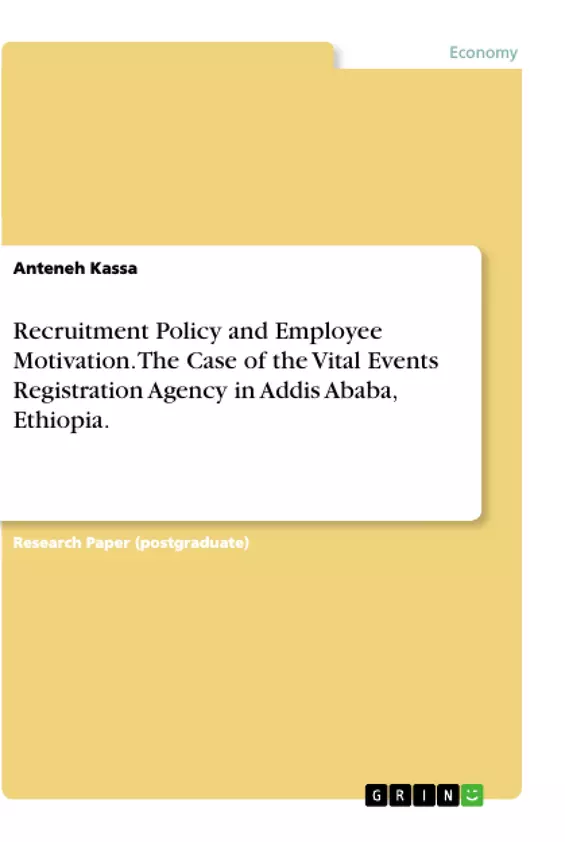This study was conducted with the general objective of assessing the current recruitment policy and employee motivation practice on job satisfaction of Addis Ababa city Administration Vital Events Registration Agency Human Resource Directorate.
To meet the above mentioned objective, the study was designed to state (Identify) the purpose and importance of recruitment and selection policy and employee motivation practice and factors that hinders not to properly accomplish the recruitment policy and employee motivation, and what are the sources of recruitment used in Addis Ababa city Administration Vital Events Registration Agency Human Resource Directorate.
The study is based on both primary and secondary data. The secondary data, which were collected from company annual reports of Human Resource Department and the primary data were collected through questionnaire and interview. The questionnaire was distributed to employees (management members and employees) at the main office who were selected using random sampling technique. The interview was conducted with the Human Resource Head. The study used correlation data analysis techniques.
Inhaltsverzeichnis (Table of Contents)
- CHAPTER ONE
- 1. Introduction
- 1.1 Background of the study
- 1.2 Statement of the problem
- 1.3 .General Objective of the study
- 1.4 Research Question
- 1.5 Significance/Importance of the study
- 1.6 Scope of the study
- 1.7. Description of the Study Area
- 1.7.1. Historical background and Administrative Structure of the Study Area
- 1.7.2. Location and Altitude
- 1.7.3. Population
- 2. Literature Review
- 1.8 Employee Motivation
- 1. Introduction
- CHAPTER THREE
- 3. Research Design and Methodology
- 3.2. Research Design
- 3.2.1. Research Approach
- 3.4. Methods of Data Collection
- 3.6. Sampling Technique
- 3.6.1. Population
- 3.6.2. Sampling frame
- 3.6.3. Sampling unit
- 3.6.4. Sampling Design (sampling size)
- 3.8. Data Presentation
- 3.9. Limitations
- 3.10. Ethical Considerations
- CHAPTER FOUR
- 1.9 . Human Resource Policy of Addis Ababa city Administration Vital Events Registration Agency
- 1.10 Data Presentation and Analysis
- CHAPTER FIVE
- 2. Conclusion and recommendation
- 2.1. Conclusion
- 2.1 Recommendation
Zielsetzung und Themenschwerpunkte (Objectives and Key Themes)
This research paper aims to assess the current recruitment policy and employee motivation practices in relation to job satisfaction at the Addis Ababa city Administration Vital Events Registration Agency's Human Resource Directorate. The study seeks to identify the purpose and importance of recruitment and selection policy, employee motivation practices, and the factors hindering the effective implementation of these policies. It also explores the sources of recruitment utilized by the agency.
- Assessment of the current recruitment policy and its effectiveness
- Analysis of employee motivation practices and their impact on job satisfaction
- Identification of factors hindering the successful implementation of recruitment and motivation policies
- Exploration of different recruitment sources employed by the agency
- Evaluation of the relationship between recruitment practices, employee motivation, and job satisfaction
Zusammenfassung der Kapitel (Chapter Summaries)
Chapter One provides an introduction to the study, outlining the background, problem statement, research objectives, research question, significance, scope, and a description of the study area. It explores the historical background and administrative structure of the agency, its location, and population.
Chapter Two delves into a review of relevant literature, exploring various aspects of employee motivation and its significance within organizations. It discusses the importance of proper employee management, the impact of motivation on performance, and the challenges and advantages associated with motivating employees.
Chapter Three details the research design and methodology employed in the study. It outlines the research approach, data collection methods, sampling technique, data presentation, limitations, and ethical considerations of the research.
Chapter Four presents the discussion and interpretation of the collected data. It examines the findings related to human resource policies, recruitment and selection practices, and employee motivation practices. It also analyzes the personal information of respondents and provides insights into the interview conducted with the Human Resource Head.
Chapter Five presents the conclusions drawn from the research, summarizing key findings and providing recommendations for improving recruitment policies and employee motivation practices at the Addis Ababa city Administration Vital Events Registration Agency.
Schlüsselwörter (Keywords)
The research focuses on recruitment policy, employee motivation, job satisfaction, human resource management, vital events registration, Addis Ababa city administration, and data analysis. The study explores the relationship between these key concepts and aims to provide insights into effective practices for enhancing employee satisfaction and organizational performance within the Addis Ababa city Administration Vital Events Registration Agency.
- Citation du texte
- Anteneh Kassa (Auteur), 2017, Recruitment Policy and Employee Motivation. The Case of the Vital Events Registration Agency in Addis Ababa, Ethiopia., Munich, GRIN Verlag, https://www.grin.com/document/591897



